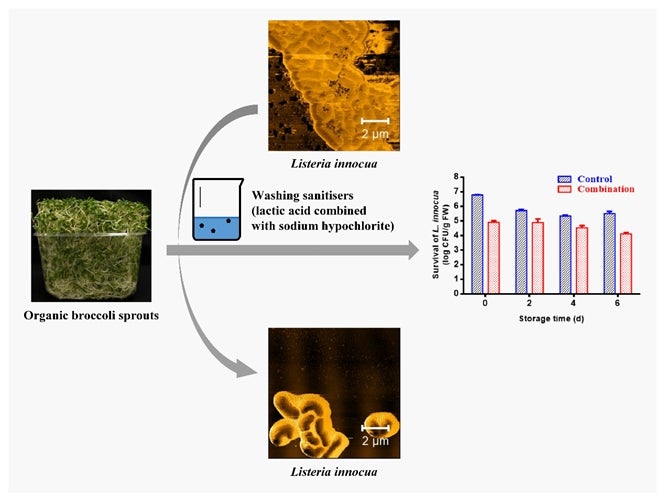Keeping food safe from bacteria
YANG Hongshun (Group Leader, Chemistry) June 07, 2019NUS food scientists have found that a combination of lactic acid with food grade sodium hypochlorite is an effective sanitiser to process fresh organic vegetables.
Organic food products such as vegetable sprouts are getting more popular as consumers become more aware of the potential benefits to their health and well-being. However, foodborne pathogen infection caused by contaminated vegetables during each stage of cultivation and postharvest process is a major issue, particularly for fresh organic vegetables. Sanitisers are commonly used in the food production industry to help kill bacteria and other microorganisms that can cause foodborne illness. Although sanitisers are commercially available, the strict regulations for organic food products limit the type of sanitisers that can be used to process organic vegetables.
A research team led by Prof YANG Hongshun from the Food Science and Technology Programme at the Department of Chemistry, NUS has found that a combination of organic acid (lactic acid, 2% v/v) and food grade sodium hypochlorite (4 mg/L) is an effective sanitiser for organic food products. The team tested the sanitisation ability of different combinations of electrolysed water, sodium hypochlorite and organic acids on organic broccoli sprouts containing a type of bacteria, Listeria innocua. Listeria innocua is a common, non-pathogenic bacterial species that has similar characteristics to the pathogenic species Listeria monocytogenes, which causes many foodborne infections. They also found that the sanitisation treatment did not have any observable adverse effects on the sensory quality (colour, texture and smell) of the organic broccoli sprouts over a storage period of six days.
Traditionally, washing sanitisers such as chlorine solutions (sodium hypochlorite, 50–200 mg/L) are commercially used to disinfect the freshly cut produce but they may not be able to meet the regulatory requirements for processing organic produce under the United State’s National Organic Program (NOP). This approach which uses sanitisers approved by the NOP is able to achieve a sanitising effect comparable to those used for freshly cut produce. In their experiments, the research team found that their approach is able to reduce the bacteria population by about 1.8 log CFU/g (colony forming units per gram) on organic broccoli sprouts after washing treatment for two minutes.
The team showed that the lactic acid was able to disrupt the cell membrane of Listeria innocua within a short time. This eventually led to cell rupture. The addition of food grade sodium hypochlorite could induce oxidative damage to the bacterial cell, making the cell walls more permeable to the lactic acid. This results in better sanitising performance.
Mr CHEN Lin, a Ph.D. student working on the project said, “The selected washing sanitisers are Generally Recognised as Safe (GRAS) and approved by the United States NOP. They are convenient, effective and relatively low cost for consumers, which makes them suitable for the food processing industry.”
“These findings provide valuable references for the organic food processing industry, especially for organic fresh-cut vegetables which are widely used for making salads,” added Prof Yang.

(Top and bottom) Atomic force microscopy images showing a decrease of Listeria innocua cells after treatment with a combination of lactic acid and food grade sodium hypochlorite. (Left) Visual of organic broccoli sprouts used in the experiments. (Right) Bar chart comparing the survival rate of Listeria innocua on organic broccoli sprouts with and without sanitisation treatment over a storage period of six days.
Reference
Chen L; Zhang H; Liu Q; Pang X; Zhao X; Yang H*, “Sanitising efficacy of lactic acid combined with low-concentration sodium hypochlorite on Listeria innocua in organic broccoli sprouts” INTERNATIONAL JOURNAL OF FOOD MICROBIOLOGY Volume: 295 Pages: 41-48 DOI: 10.1016/j.ijfoodmicro.2019.02.014 Published: 2019.


